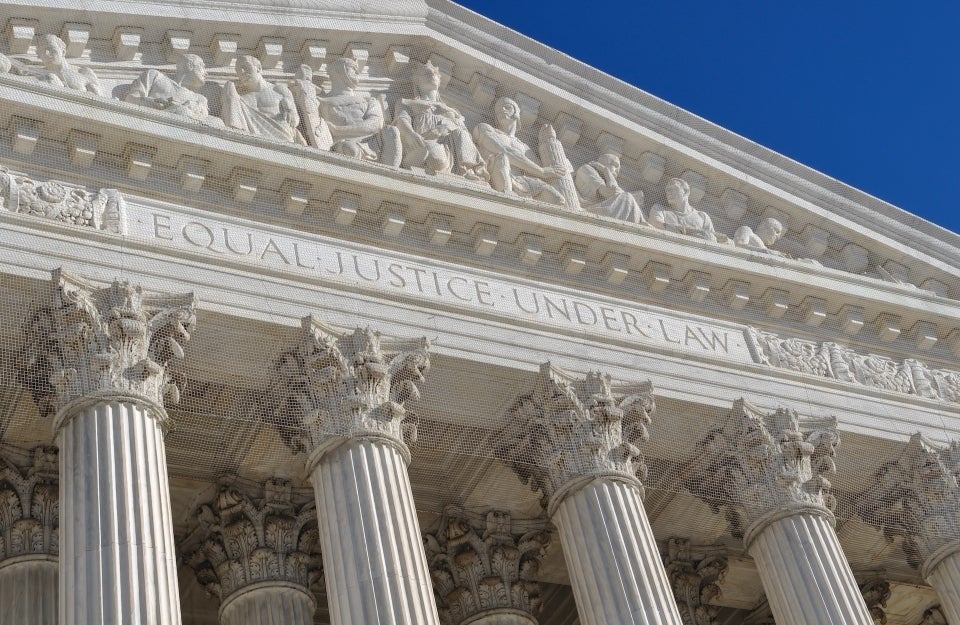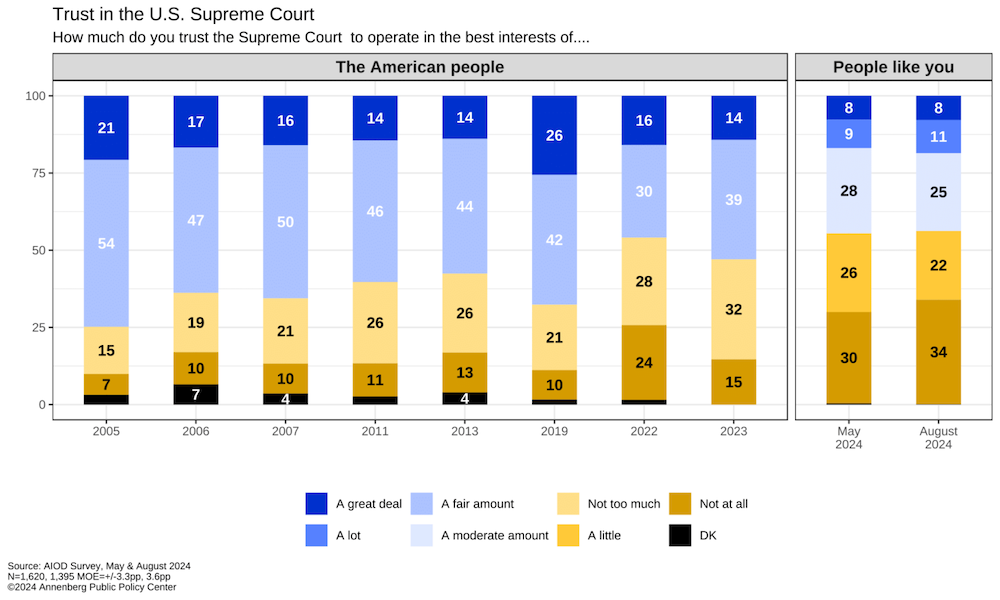Trust in U.S. Supreme Court Continues to Sink
A new survey by the Annenberg Public Policy Center has found that public trust in the U.S. Supreme Court has continued a downward slide since the court’s 2022 Dobbs decision.

Driven by political partisanship, public trust in the U.S. Supreme Court has continued a downward slide since the court’s 2022 Dobbs decision overturning the Roe v. Wade ruling that established a constitutional right to abortion, according to a new survey by the Annenberg Public Policy Center (APPC) at the Annenberg School for Communication at the University of Pennsylvania.
More than half of Americans (56%) now disapprove of the Supreme Court, saying they trust it either “a little” or “not at all” to act in the best interest of “people like you,” according to the nationally representative panel survey conducted in July and August 2024.
Support for the court stands at 44%, with 8% expressing “a great deal” of trust, 11% “a lot” of trust, and 25% “a moderate amount” of trust in the court to act in the best interest of people like you. It is the lowest overall level of trust since APPC began surveying the American public on this issue in 2005, when 75% of the public trusted the court.
Highlights
The new survey, conducted among a nationally representative sample of 1,395 adult U.S. citizens, was fielded July 12-August 12, 2024, following the court’s 2023-24 term, which concluded on July 1 with the court’s ruling in the Capitol insurrection case that Donald Trump has immunity from criminal prosecution for official acts he took as president. The same sample of respondents was previously surveyed in May 2024, during the court term.
In August 2024, 44% overall have trust in the Supreme Court, about the same as 45% in May. But the 40-point spread in trust seen in May between Republicans and Democrats widened significantly to 47 points in August, with 71% of Republicans, 41% of independents, and 24% of Democrats having trust in the court to act in their best interest. Download the topline here.

Earlier APPC surveys found that trust in the court plummeted 22 points after the Dobbs decision, from 68% in 2019 to 46% in 2022. The current survey shows that after a modest rebound, trust has continued to slip, hitting 44% in August 2024. It also finds:
- Growing numbers have no trust in the court: Asked how much, if at all, do you trust the court to act in the best interest of people like you, 1 in 3 people (34%) in August say “not at all,” up from 30% in May. In a 2005 APPC survey, only 7% did “not at all” trust the court, which shows a stunning increase in distrust over the past two decades.
- Partisan split growing even wider: Over the three-month period from May to August, partisan divisions in views of the court increased significantly. In May, the parties were divided, with Republicans seeing the Supreme Court more favorably, trusting it more, vesting greater legitimacy in it, and being less willing to endorse potential reforms to the court than Democrats and independents. After the court term, the gap separating Republicans from both Democrats and independents grew on each of these dimensions.
- Favorability drops in key swing states: Since 2021, APPC has reinterviewed the same set of respondents in Michigan, Pennsylvania, and Wisconsin. These data allow us to compare views of the court from 2021, before the court’s Dobbs decision, to today, two years after that landmark ruling. Over that time, we have seen a dramatic decline in the public’s view of the court – mostly from a decrease in support from both Democrats and independents.
“This underscores how Dobbs has fundamentally shifted views of the court,” said University of Pennsylvania political science professor Matthew Levendusky, the Stephen and Mary Baran Chair in the Institutions of Democracy at the Annenberg Public Policy Center and director of the survey. “For many years, the court was held in high esteem by all Americans across partisan lines, but no more – that polarization emerged after Dobbs, and the court’s rulings since then have done little to change these perceptions.”

Partisan differences in attitudes toward the court
For decades, the Supreme Court had been seen as one of the few institutions respected by Republicans and Democrats alike. In a journal article this year, Annenberg Public Policy Center researchers said the court had been primarily regarded as a legal institution, not a political one, strengthened by its “norms, processes, symbols, and independence,” and was therefore afforded greater public trust and legitimacy than other institutions. (See “Has the Supreme Court become just another political branch? Public perceptions of court approval and legitimacy in a post-Dobbs world” in Science Advances.)
A second article this year by APPC researchers found that declining trust in the Supreme Court was mirrored in the federal judiciary, with the percentage of Americans with either “a great deal” or “a fair amount” of trust and confidence in the judicial branch falling to under 50% in 2022 from 75% in 2000. (See “The withering of public confidence in the courts” in Judicature.)
Evidence from three swing states
Surveys conducted in three swing states – Michigan, Pennsylvania, and Wisconsin – bolster these findings. Panelists were asked about their favorability toward the court on six occasions from November 2021 through August 2024. These results show that:
- Before and after Dobbs, there is a dramatic decline in the public’s view of the court. In 2021, before the decision, the average respondent had a “neither favorable nor unfavorable” view of the court, but post-Dobbs in 2022, that fell 31%, to just more than “somewhat unfavorable” on average and it has remained below pre-Dobbs levels since.
- This decrease in support for the court comes mostly from changes among Democrats and independents. In 2021, the difference between the two parties was relatively small, with little partisan polarization in views of the court. Today the gap in favorability between the parties has more than doubled, a 101% increase.

About the surveys
The most recent findings are based on two ongoing Annenberg Institutions of Democracy (AIOD) panel studies, surveys that interview the same sets of voters over time. One is a nationally representative sample of adult U.S. citizens, while the other is a sample of adult U.S. citizens living in Michigan, Pennsylvania, and Wisconsin (the sample in each state is drawn to be representative of adults living in that state). Both sets of respondents were interviewed from May 1-23, 2024, and from July 12-August 12, 2024. The swing state samples have also been interviewed roughly quarterly since May 2020.
Data collection for the national panel was conducted from May 1-23, 2024, among a sample of 1,620 adult U.S. citizens, divided in three subgroups. The margin of sampling error (MOE) for the complete set of weighted data is ± 3.3 percentage points at the 95% confidence level. The panel survey was conducted again July 12-August 12, 2024, among a sample of 1,395 U.S. adult citizens, with a margin of error of ± 3.6 percentage points.
Download the topline and methodology here.
For more information on the sampling of the swing state panel, see the Appendix for the book “Democracy Amid Crises,” available at https://osf.io/487jk/
The battery of survey questions about court reform was developed under the supervision of Matt Levendusky, director of the AIOD national panel at the Annenberg Public Policy Center. The analysis and graphics were prepared by APPC research analyst Shawn Patterson Jr. The team supervising the survey also includes Kathleen Hall Jamieson, the director of APPC, and Ken Winneg, APPC’s managing director of survey research.
The Annenberg Public Policy Center was established in 1993 to educate the public and policy makers about communication’s role in advancing public understanding of political, science, and health issues at the local, state, and federal levels.



